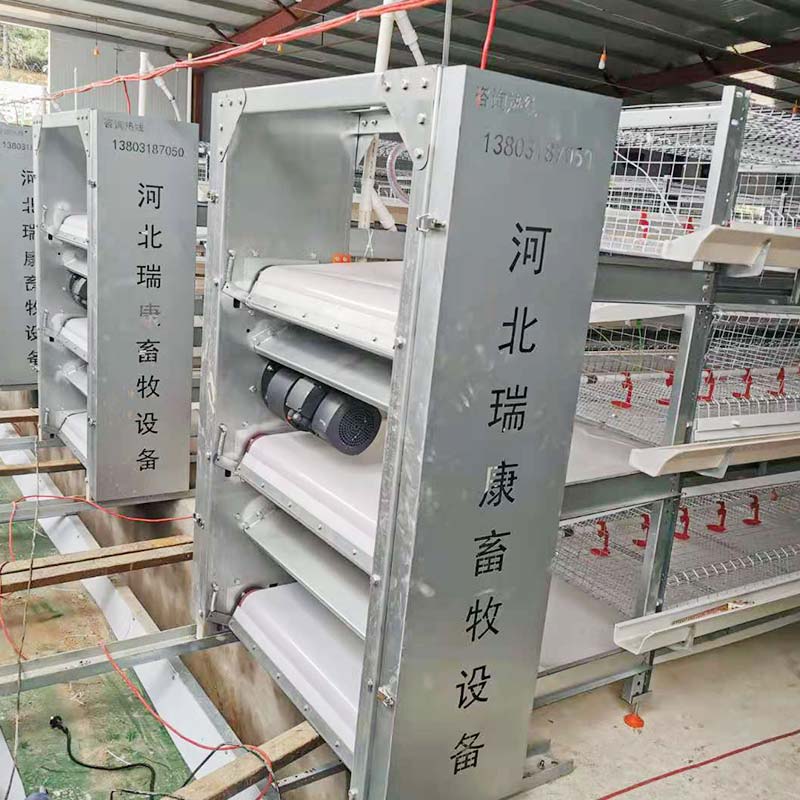Many people who want to build a chicken farm want to know what equipment and equipment are needed to build a new chicken farm, and how to build a chicken coop in a fair way? What chicken coop equipment is required?
one. chicken coop
(1) Assembly of chicken cages: The form of assembling a single chicken cage into a cage group.
Full-door chicken cage: The upper and lower cages are completely staggered, and the common ones are 2-3 layers. Its advantages are: no manure board is required at the bottom of the cage, and no manure removal system is required if it is a manure pit; the layout is simple; the ventilation and light surfaces of each cage are large. The disadvantages are: large area, low breeding density, and more investment in equipment deployment.
Half-door chicken cage: the upper and lower cages overlap 1/4-1/2, and a certain angle of manure baffle is placed above the overlapping part of the grassroots. Its ventilation performance is worse than that of the full-door type, but the breeding density is higher.
Overlapping chicken cages: The upper and lower cages are completely overlapped. The common ones are 3-4 layers, and the high ones can reach 8 layers. The breeding density is greatly improved. Its advantages are: high utilization rate of chicken house and excellent production efficiency. The disadvantages are: the construction of the chicken house, the deployment of ventilation equipment, and the deployment of manure removal equipment have high requirements, which are not easy to inspect the chicken flocks, and are difficult to handle.
Single-layer parallel type: The top net of the cage is at the same level. Although the stocking density is high and the utilization rate of the chicken house is high, there is no significant division of cage groups and lanes, and management and feeding are difficult.
(2) Breeding chicken cages: 2-3 layers of overlapping or semi-door cages are usually used.
(3) Breeder cages: There are single-layer cages and two-layer artificial insemination cages. The former is the natural mating of male and female cages. The latter is often used in artificial insemination chicken farms, and the original breeder farms are
It can also be accepted when individual egg laying records of pure lines are carried out.

2. Deployment of drinking water equipment
Drinking water equipment deployment includes pumps, water towers, filters, limiting valves, drinking fountains, and piping methods. Common examples of drinking fountains include:
(1) Long water tank: Its advantages are simple layout, low cost, and easy drinking water immunity. The disadvantage is that it consumes a lot of water, is easily polluted, and has a large amount of scrubbing.
(2) Vacuum drinking fountain: its advantage is that the water supply is balanced and easy to use. The disadvantage is that the amount of washing is large, and it cannot be used when the amount of drinking water is large.
(3) Nipple drinking fountain: Its advantage is that it not only saves water, but also is conducive to epidemic prevention, and it does not need to be washed and replaced frequently. The disadvantage is that each layer of chicken coop needs to be equipped with a decompression water tank.
Unfortunately, drinking water is immune, and the requirements for raw materials and manufacturing precision are also high.
(4) Cup drinking fountain: its advantage is that it can supply water according to the necessary amount, saving water. The disadvantage is that the water cup needs to be washed frequently, and it needs to be equipped with a filter and a water pressure adjustment device.
(5) Hanging tray drinking fountain: The advantage is that it saves water and is easy to wash. The disadvantage is that the height of the drinker needs to be adjusted according to the different growth stages of the flock.
3. Feeding equipment deployment:
It includes four parts: storage tower, feeder, feeder and feeding trough. The storage tower is usually located at one end or side of the chicken house, and the feed is sent to the feeding trough by the feeder.
(1) Chain plate feeding machine: It is widely used in flat raising and various cage raising chicken houses.
(2) Coil spring feeder: widely used in flat-growing chicken houses.
(3) Plug pan feeder: One feeder can feed 2-3 chicken houses at the same time. However, when the plug plate or steel cable is broken, it is difficult to repair and requires a high level of installation skills.
(4) Feeding trough: Flat-raised chickens are used more. It can be made into long, medium and small size troughs.
(5) Feeding barrel: It is a commonly used feeding equipment deployment in the contemporary chicken industry.
(6) Bucket feeder and traveling feeder: mostly used for multi-layer chicken cages and overlapping cage chicken houses.
4. Deployment of manure cleaning equipment:
(1) Traction type manure scraper: It is usually composed of a tractor, a manure scraper, a frame, a wire rope, a steering pulley, a wire rope rotator, etc. It is mainly used for cleaning manure in one or more manure ditches on a unified plane. The manure scraping boards in two adjacent manure ditches are connected by steel wire ropes. It can also be used for upstairs and downstairs linkage cleaning. The structure of the machine is relatively simple and easy to maintain, but the wire rope is easily broken by chicken manure.
(2) Conveyor belt cleaning: It is often used for the cleaning of high-density overlapping cages. The excrement falls directly on the conveyor belt through the bottom net, which can save the manure bearing plate and the manure ditch. Adopt high-bed chicken coops, the chicken manure falls directly into the deep pit, and the accumulated manure is cleared after one year, which is very convenient.
Copyright:@2020-2021
Comments Please sign in or sign up to post.
0
0 of 500 characters used